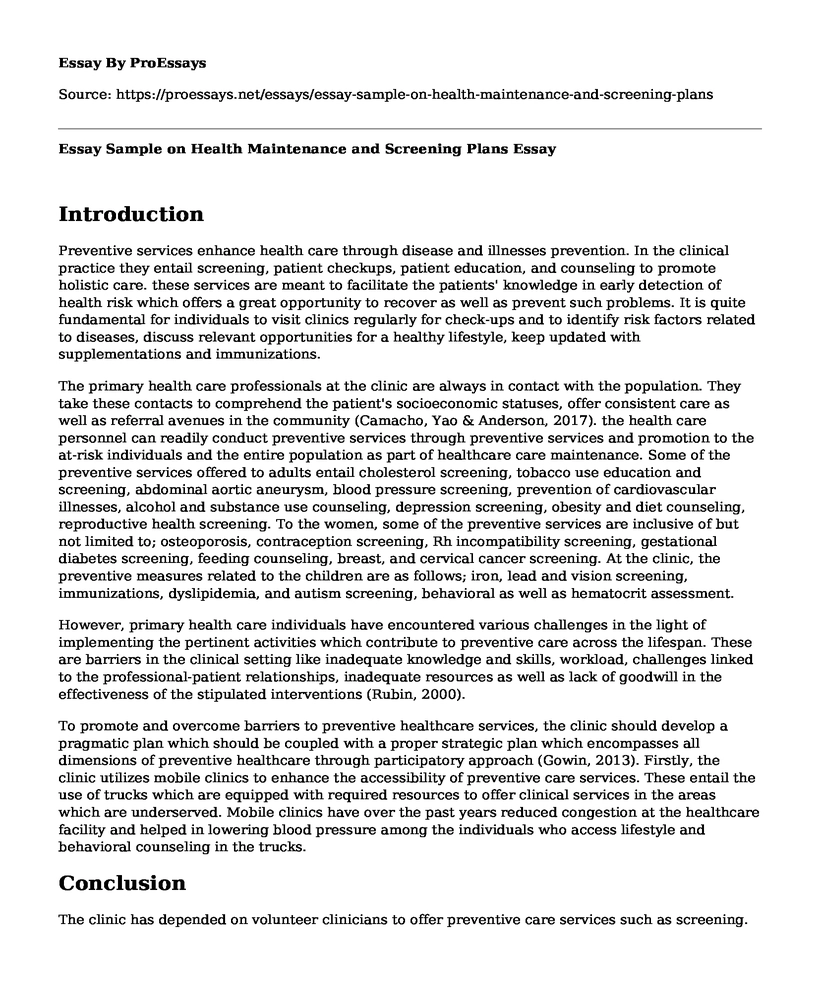Introduction
Preventive services enhance health care through disease and illnesses prevention. In the clinical practice they entail screening, patient checkups, patient education, and counseling to promote holistic care. these services are meant to facilitate the patients' knowledge in early detection of health risk which offers a great opportunity to recover as well as prevent such problems. It is quite fundamental for individuals to visit clinics regularly for check-ups and to identify risk factors related to diseases, discuss relevant opportunities for a healthy lifestyle, keep updated with supplementations and immunizations.
The primary health care professionals at the clinic are always in contact with the population. They take these contacts to comprehend the patient's socioeconomic statuses, offer consistent care as well as referral avenues in the community (Camacho, Yao & Anderson, 2017). the health care personnel can readily conduct preventive services through preventive services and promotion to the at-risk individuals and the entire population as part of healthcare care maintenance. Some of the preventive services offered to adults entail cholesterol screening, tobacco use education and screening, abdominal aortic aneurysm, blood pressure screening, prevention of cardiovascular illnesses, alcohol and substance use counseling, depression screening, obesity and diet counseling, reproductive health screening. To the women, some of the preventive services are inclusive of but not limited to; osteoporosis, contraception screening, Rh incompatibility screening, gestational diabetes screening, feeding counseling, breast, and cervical cancer screening. At the clinic, the preventive measures related to the children are as follows; iron, lead and vision screening, immunizations, dyslipidemia, and autism screening, behavioral as well as hematocrit assessment.
However, primary health care individuals have encountered various challenges in the light of implementing the pertinent activities which contribute to preventive care across the lifespan. These are barriers in the clinical setting like inadequate knowledge and skills, workload, challenges linked to the professional-patient relationships, inadequate resources as well as lack of goodwill in the effectiveness of the stipulated interventions (Rubin, 2000).
To promote and overcome barriers to preventive healthcare services, the clinic should develop a pragmatic plan which should be coupled with a proper strategic plan which encompasses all dimensions of preventive healthcare through participatory approach (Gowin, 2013). Firstly, the clinic utilizes mobile clinics to enhance the accessibility of preventive care services. These entail the use of trucks which are equipped with required resources to offer clinical services in the areas which are underserved. Mobile clinics have over the past years reduced congestion at the healthcare facility and helped in lowering blood pressure among the individuals who access lifestyle and behavioral counseling in the trucks.
Conclusion
The clinic has depended on volunteer clinicians to offer preventive care services such as screening. The clinic is usually faced with a short timeframe for offering preventive care activities and for this reason, partnerships with co-hosts clinics have facilitated the provision of quality healthcare services which helps the locals manage their health matters for better livelihoods. Moreover, the clinic has established a healthcare access team in participation with community stakeholders to provide transportation of patients to available facilities (Miller & Peterson, 2018). The clinic has discovered the essence of the participatory approach in offering these services since it builds a good rapport with the community members. The clinic holds in high regards the health asset mapping process to put emphasis on the pressing needs. Besides, the clinic has publicized relevant information and resources for the community to develop plans and derive solutions to the most pressing needs.
References
Camacho, F., Yao, N., & Anderson, R. (2017). The effectiveness of Medicare wellness visits in accessing preventive screening. Journal of Primary Care & Community Health, 8(4), 247-255. doi: 10.1177/2150131917736613
Gowin, E. (2013). Barriers in the delivery of preventive procedures in primary health care. Family Medicine & Medical Science Research, 1(1). doi: 10.4172/2327-4972.1000101
Miller, M., & Peterson, T. (2018). 10 Ways hospitals can improve healthcare access. Retrieved from https://stakeholderhealth.org/healthcare-access/Rubin, H. (2000). Overcoming barriers to preventive care. Journal of General Internal Medicine, 15(6), 434-436. doi: 10.1046/j.1525-1497.2000.115600.x
Cite this page
Essay Sample on Health Maintenance and Screening Plans. (2022, Oct 21). Retrieved from https://proessays.net/essays/essay-sample-on-health-maintenance-and-screening-plans
If you are the original author of this essay and no longer wish to have it published on the ProEssays website, please click below to request its removal:
- Paper on Down Syndrome
- Sociology Essay Example on Supplemental Nutrition Assistance Program
- Immunotherapy of Cancers Using Dendritic Cell Vaccines Essay
- Specific Change Within an Organization and its Impacts - Paper Example
- Comprehensive Emergency Management Plan (CEMP)
- Essay Example on Fire Investigation Process: Sizing Up & Responding Instantly
- Paper Example on Integrity and Humility: A Nurse Leader's Core Values







